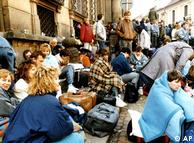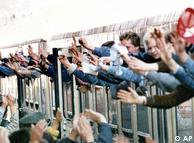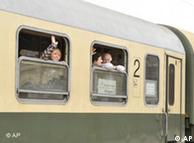HISTORY | 02.10.2009
Historic East German refugee train rolls again
The Freedom Train was the beginning of East Germany's peaceful revolution, paving the way for the fall of the Berlin Wall and subsequently the fall of communism. On October 1, 1989, the train left Prague, then the capital of Czechoslovakia, and travelled to the town of Hof in what was then West Germany.
After the East German government closed the border to Hungary, the last chance for people to leave the country was via Czechoslovakia. The West German embassy was the most easily accessible outpost of the world inside the Iron Curtain countries and so, in late September, thousands of East Germans flocked to the embassy grounds and set up camp.
The 4,000 or so East Germans stayed there for five days, hoping that they would be allowed to leave the communist East. Thousands of people camped out, waiting for the trains
Thousands of people camped out, waiting for the trains
After tough negotiations, it was agreed that the people camped at the embassy would be granted their wish, but the East German government had one condition: the train had to travel through East Germany.
West Germany's foreign minister at the time, Hans-Dietrich Genscher, flew to Prague to pass on the good news and to reassure those who were to board the train.
"It was clear to me that if I tell them your trains must go through the East, they will be afraid, Genscher said at a press conference in Prague this week as part of the 20th anniversary celebrations.
"I could tell them: nothing will happen to you."
The Freedom Train travels again
Mirko Sennewald, who was only 15 years old when he and his mother boarded the "Freedom Train," is the man behind the recreation of the journey 20 years later.
He says the East German government's decision to force the train to travel through the East was a political mistake.
 Hundreds of West Germans welcomed the refugees
Hundreds of West Germans welcomed the refugees
"The people along the route started with demonstrations and that's why it's the symbol for the revolution – because the people, for the first time, stood up after 40 years," Sennewald told Deutsche Welle.
The most violent demonstrations along the train route occurred in the cities of Dresden and Freiberg. Twenty years later, witnesses of the event said that police seemed to be caught completely off guard.
In the end, 12,000 people left East Germany on 14 trains between October 1 and 8, 1989. Today, the trains are considered a symbol of the revolution, and large crowds of people turned out to greet the Freedom Train as it retraced the journey of the original.
Christina Gerlauf, who was 21 at the time, said people 20 years ago had a feeling that something was happening in the country.
"We could not say what it was, but we knew a rumor among the people, that they would not accept the situation anymore," Gerlauf said.
Just four weeks after the original Freedom Train journeys, the Berlin Wall came down, and within a year, the East German regime crumbled.
"It was just a miracle that that could happen," said Gerlauf.
Author: Tanya Wood / ca
Editor: Nancy Isenson


"it was just a miracle that that could happen,"said Gerlauf.
ReplyDelete